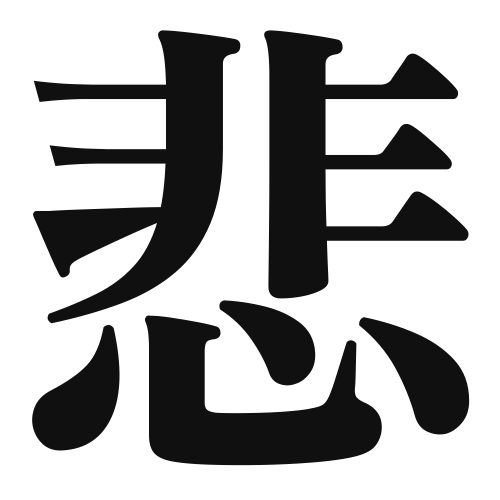1. Overview of Meaning
The kanji “悲” (hi) means “sad” or “sorrowful.” It expresses feelings of grief, melancholy, or unhappiness. This character is often used to convey emotional pain or distress.
2. Formation and Radical
The kanji “悲” is a compound character (会意文字) that combines two elements: the radical for “heart” (心) and the character “非” (hi), which can imply negation or something that is not. Together, they convey the idea of a heart that is not at peace, symbolizing sadness.
The radical of “悲” is 心 (kokoro), which relates to emotions and feelings.
3. Examples of Usage
Common words and phrases that include “悲” are:
- 悲しい (kanashii) – sad
- 悲劇 (higeki) – tragedy
- 悲しみ (kanashimi) – sorrow
Example sentences in daily conversation:
- 彼は悲しいニュースを聞いた。 (Kare wa kanashii nyūsu o kiita.) – He heard sad news.
- この映画は悲劇的な結末を持っている。 (Kono eiga wa higekiteki na ketsumatsu o motte iru.) – This movie has a tragic ending.
4. Synonyms and Antonyms
Similar kanji with related meanings include:
- 哀 (ai) – which also means sorrow but often has a deeper, more poignant connotation.
- 憂 (yuu) – which means to be worried or anxious, focusing more on mental distress.
Antonyms include:
- 喜 (ki) – which means joy or happiness.
- 楽 (raku) – which means comfort or ease.
5. Cultural and Historical Background
The kanji “悲” is deeply rooted in Japanese culture, often appearing in literature, poetry, and art to express the complexities of human emotions. It is associated with the concept of mono no aware, which refers to the beauty of transient things and the sadness that comes with their impermanence.
Common proverbs and idioms include:
- 悲しみは分かち合うことで軽くなる。 (Kanashimi wa wakachi au koto de karukunaru.) – Sorrow becomes lighter when shared.
